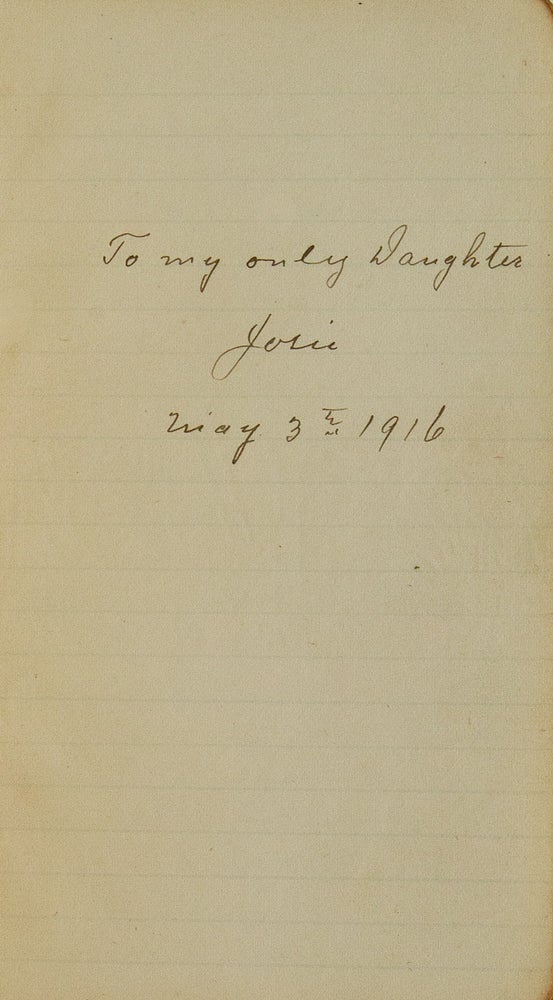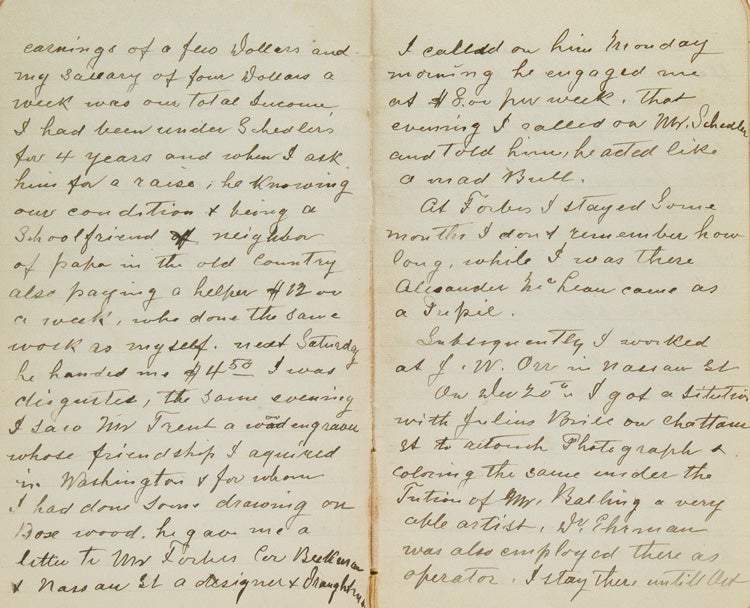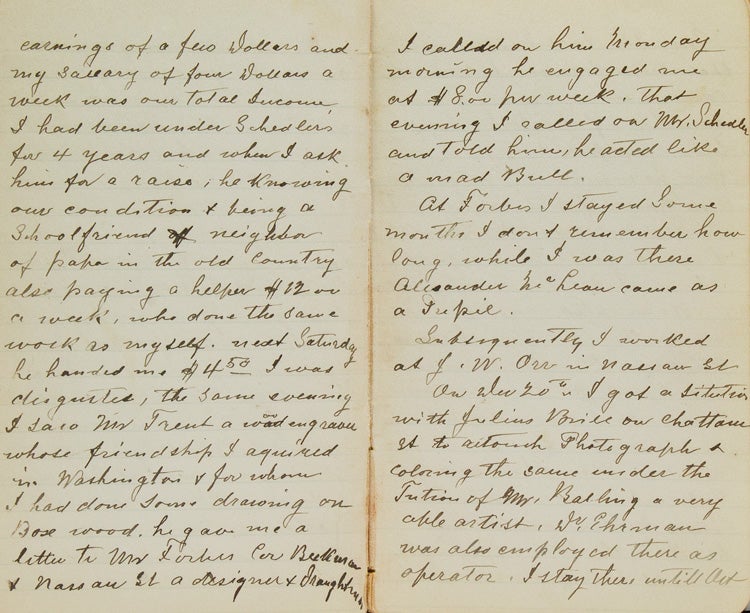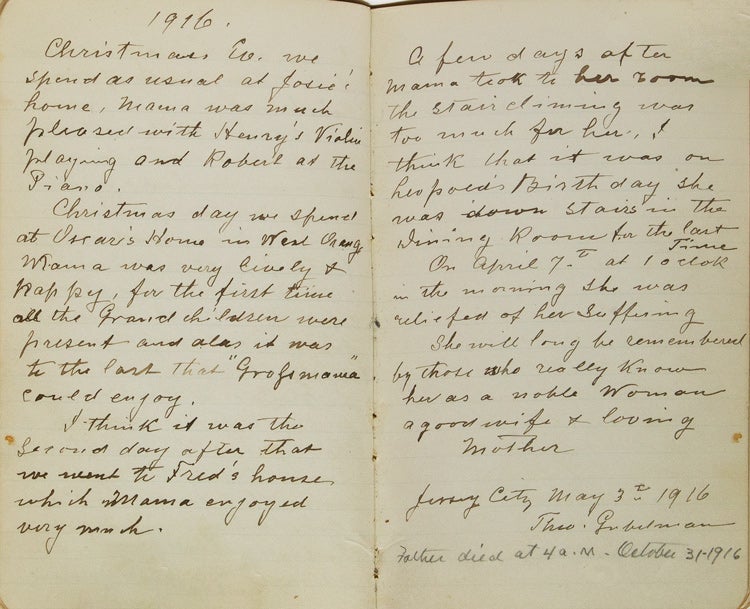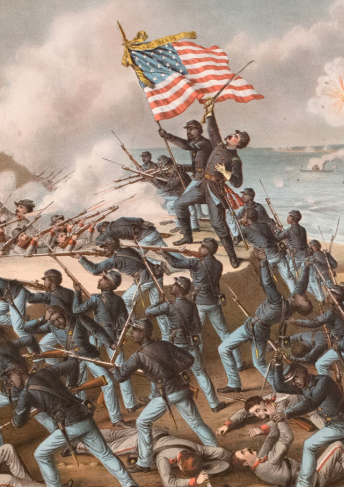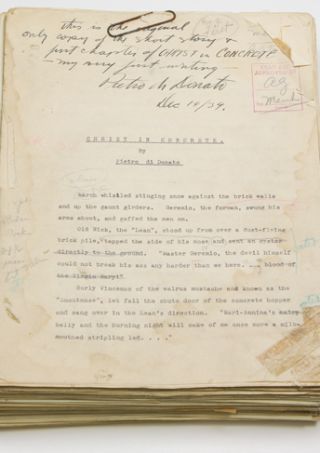Autobiographical Manuscript Memoir of a 19th Century American Photographer
Autograph memoir of a noted New Jersey photographer, including his work as an itinerant photographer during the Civil War.
Jersey City, NJ: May 3, 1916.
Price: $3,500.00
About the item
Manuscript throughout. 61pp., neatly written in ink on ruled paper. Inscribed on the first page "To my only daughter Josie" and signed and dated on the final page. 12mo. Autobiographical Manuscript Memoir of a 19th Century American Photographer. Contemporary flexible leather covers. Binding worn. Saretsky, Gary D.; and Joseph C. Bilby "Photographers of the Civil War Era: Theodore Gubelman of Jersey City" in NJS: An Interdisciplinary Journal (Winter 2021).
Item #321536
Born on November 9, 1841, in Constance, Baden-Württtemberg, Germany, Gubelman arrived in New York in May 1854. The following year he found work with famed mapseller J. H. Colton "as pupil to Jos. Schedler who was in charge of the engraving dept, a ledding man as engraver of maps." In 1857, he relocates to Washington DC with Schedler, to draw maps on boxwood for wood engraving, though the following year he returned to New York, working as an engraver for Forbes in New York, being paid $8.00 a week.
In 1858 he accepts his first job in photography:"On Dec. 20th I got a situation with Julius Brille on Chatham St. to retouch photograph & coloring the same under the tuition of Mr. Bathing a very able artist. Dr. Ehrman was also employed there as operator." Gubelman stayed in that position less than a year before moving to Memphis, Tennessee to work in a family friend's grocery business. "I stayed one month in that business but it did not prove congenial to me, so I secured a situation in Clark's Gallery the most noted in Memphis as a colorist" He returned to the grocery business shortly thereafter when the owner sold his interest to Gubelman's family. "The summer of 1860 was a very trying time in Memphis particularly for a good republican. The only thing to do was to keep mum, a hard thing to do when you hear the most patriotic men of the nation abused like pick pockets. Homeguards were organized uniformed and drilled in the evening, attending to business during the day and wearing the uniform as a protection against being pressed into the rebel army." He leaves the south under the pretense of purchasing stock for the store and smuggles himself north by flagging down a steamer on the Ohio River, making his way back to Jersey City.
His memoir continues: "I hired Campbell's Gallery at 60 Montgomery St he having gone into making plates for tintypes then just coming up. I improved in my chemical knowledge under Mr. Campbell, done my own operating and colored photographs and made a fairly good living." In May, however, he enlists for 3-months service "in response to Pres. Lincoln's call for 75,000." His service was largely uneventfully, spending most of his time at Suffolk, Virginia, with the exception of being shipwrecked en route to Fortress Monroe. He mustered our honorably in September, and joined by his parents, moved to Trenton "where I founded the partnership Parker & Gubelman & opened a gallery on East State St. We did not succeed and due no doubt to inexperience of both of us."
In May 1863 he "entered the employ of C.C. Giers at Nashville Ten. at a salary of $80 a month which was increased to $100 in Aug." After Giers retirement, and a brief stint working "in a photo tent at a camp in Murfreesboro" he befriends Captain Welles, who loans him $400 to open his own studio. "I located at Pulaski, Ten. There was about 10,000 soldiers and no photographer ... There was a fine skylight on the square one flight up. I got an order from the Provost Marshal to take possession. On Jan. 11th 64 I came back to Pulaski with the needed stock and an old acquaintance who was a printer, we went to work to fit up, prepare chemicals, that was collodion days when it took time to get in working order ... In the first day I took in $37.00. By the middle of March I paid back the loan to Capt. Welles, as he would take no interest I presented a gold watch to Mrs. Welles."
By May, however, Union troops left Pulaski and Gubelman returned to Nashville with $500 in stock & $1000 in cash." He entered into partnership with his former boss Giers. "So we formed the firm C.C. Giers & Co. Mr. Giers put up $4000 cash & I $1000 in cash & $500 in stock we bought the Merrit Gallery for $5000. Mr. Giers was to have 2/3 interest." Just a few months later however, with Sherman marching towards Atlanta, Giers bought out Gubelman's share for $2600 and Gubelman again returned to Jersey City, where he opened his own studio on Newark Avenue in May 1865. After describing the meeting his future wife, his marriage and other family news, Gubelman records the opening of a second gallery on Washington Street in Hoboken, which would be sold two years later to Louis Nagel.
He moves several times in the early 1870s, but prospers: "For a number of years I was an exhibitor at the Am. Institute Fairs, obtaining a number of medals. In 1878 I made an exhibit of Photo Portraits all sizes from cabinet size to 18 x 22 life size all from gelatin plates, the first exhibit of its kind in this country. The same year I made an exhibit in Paris and obtained a bronze medal. All of which not only was a fine advertisement but materially helped to establish a fine reputation in every way. I was also the producer of the first photo prints of instantaneous views of yachts Steamers & Co. in N.Y. art stores." He goes into partnership in 1882 with Arthur Hargrave on W. 23rd street in New York, which after several years became profitable. In 1888, he travelled with his family to Europe and while there he arranges for his son Leopold to study with Dr. Eder in Vienna "as I thought a scientific education in the photo-mechanical processes would insure his future."
Gubelman profitably dissolves his partnership with Hargrave in 1892. The rest of the memoir is devoted to his European travels, his family, and his grandchildren. The memoir ends recording the death of his wife on April 7, 1916 and with Gubelman signing and dating the memoir Jersey City, May 3, 1916. A pencil notation below, presumably by his daughter Josie, records her father's death on October 31, 1916.
Though unpublished, the memoir is known from a transcript of a second copy of the memoir, penned for his son Fred. The transcript is located at the George Eastman House, though the whereabouts of the original manuscript presented to Fred is unknown (though at one point belonged to his grandson Herbert Gubelman). For a detailed biography of Gubelman, see Saretsky and Bilby, whose article is based on a second copy of the transcript of the manuscript penned for Fred Gubelman and given to A.J. Peluso for a 1999 article in the Maine Antique Digest.

